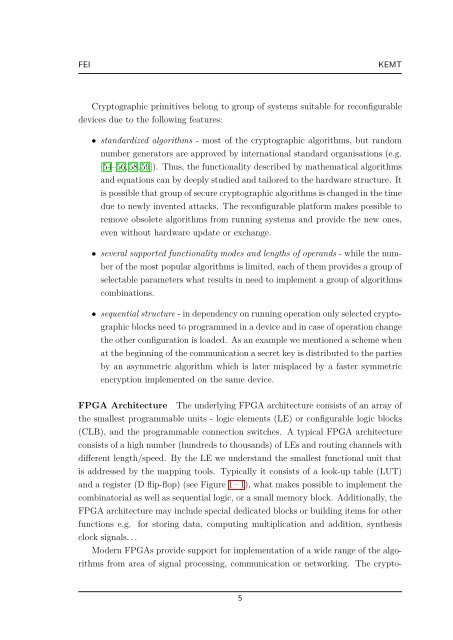1 Montgomery Modular Multiplication in Hard- ware
1 Montgomery Modular Multiplication in Hard- ware
1 Montgomery Modular Multiplication in Hard- ware
Create successful ePaper yourself
Turn your PDF publications into a flip-book with our unique Google optimized e-Paper software.
FEI KEMT<br />
Cryptographic primitives belong to group of systems suitable for reconfigurable<br />
devices due to the follow<strong>in</strong>g features:<br />
• standardized algorithms - most of the cryptographic algorithms, but random<br />
number generators are approved by <strong>in</strong>ternational standard organisations (e.g.<br />
[54–56,58,59]). Thus, the functionality described by mathematical algorithms<br />
and equations can by deeply studied and tailored to the hard<strong>ware</strong> structure. It<br />
is possible that group of secure cryptographic algorithms is changed <strong>in</strong> the time<br />
due to newly <strong>in</strong>vented attacks. The reconfigurable platform makes possible to<br />
remove obsolete algorithms from runn<strong>in</strong>g systems and provide the new ones,<br />
even without hard<strong>ware</strong> update or exchange.<br />
• several supported functionality modes and lengths of operands - while the num-<br />
ber of the most popular algorithms is limited, each of them provides a group of<br />
selectable parameters what results <strong>in</strong> need to implement a group of algorithms<br />
comb<strong>in</strong>ations.<br />
• sequential structure - <strong>in</strong> dependency on runn<strong>in</strong>g operation only selected crypto-<br />
graphic blocks need to programmed <strong>in</strong> a device and <strong>in</strong> case of operation change<br />
the other configuration is loaded. As an example we mentioned a scheme when<br />
at the beg<strong>in</strong>n<strong>in</strong>g of the communication a secret key is distributed to the parties<br />
by an asymmetric algorithm which is later misplaced by a faster symmetric<br />
encryption implemented on the same device.<br />
FPGA Architecture The underly<strong>in</strong>g FPGA architecture consists of an array of<br />
the smallest programmable units - logic elements (LE) or configurable logic blocks<br />
(CLB), and the programmable connection switches. A typical FPGA architecture<br />
consists of a high number (hundreds to thousands) of LEs and rout<strong>in</strong>g channels with<br />
different length/speed. By the LE we understand the smallest functional unit that<br />
is addressed by the mapp<strong>in</strong>g tools. Typically it consists of a look-up table (LUT)<br />
and a register (D flip-flop) (see Figure 1 – 1), what makes possible to implement the<br />
comb<strong>in</strong>atorial as well as sequential logic, or a small memory block. Additionally, the<br />
FPGA architecture may <strong>in</strong>clude special dedicated blocks or build<strong>in</strong>g items for other<br />
functions e.g. for stor<strong>in</strong>g data, comput<strong>in</strong>g multiplication and addition, synthesis<br />
clock signals. . .<br />
Modern FPGAs provide support for implementation of a wide range of the algo-<br />
rithms from area of signal process<strong>in</strong>g, communication or network<strong>in</strong>g. The crypto-<br />
5

















